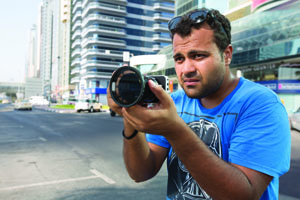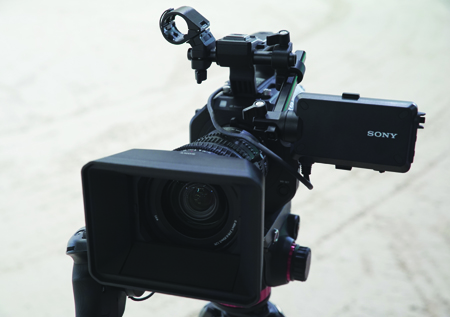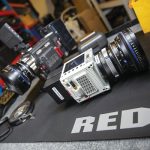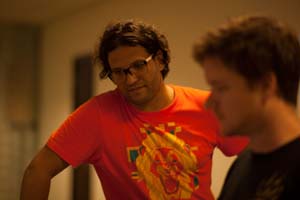Filmmaker Asif Limbada was the first person in the Middle East to receive the much-awaited Blackmagic Pocket Cinema Camera. He shares his experience in an exclusive review with BroadcastPro ME this month. For filmmaker Asif Limbada it was love at first sight when he saw the Blackmagic pocket cinema camera at NAB this year. He […]
Filmmaker Asif Limbada was the first person in the Middle East to receive the much-awaited Blackmagic Pocket Cinema Camera. He shares his experience in an exclusive review with BroadcastPro ME this month.

For filmmaker Asif Limbada it was love at first sight when he saw the Blackmagic pocket cinema camera at NAB this year. He takes a closer look at the camera to find out what its really worth
I recall the first time I saw Blackmagic Designs Pocket Cinema Camera (BMPCC) when it was unveiled at NAB 2013. I had come to Vegas with the intention of placing an order for the RED DRAGON, which was also being released at the same show. But the BMPCC caught my eye and I was, like many others, awed by its size, its features, its form factor and more importantly, its price point of USD 995.
And why wouldnt I be? Although small like any other Micro Four Third (MFT) mirrorless camera, this one can do CinemaDNG RAW and ProRes 422 (HQ) at 1080p.
The possibilities this poses are endless as I am a RAW guy and have worked with RAW codecs ever since I acquired my first RED EPIC a few years ago.
The BMPCC with its 13-stops of dynamic range at such a low price point opens a world of opportunities for filmmakers to go out and shoot more content and make art. It allows them to flirt with RAW technology, so they become more competent using high-end digital cinema cameras when they get more serious. Pocket Cinema Camera is the gateway drug to RAW digital capture. Period.
To me, it appears to be a hobbyist camera like the 5D although thats not to say that it cannot be used in a professional environment. But CinemaDNG is not yet enabled, in a typical get it out, sort it later BMD fashion. While we are at it, I find it a bit annoying that it does not do any stills although yes, Im aware that this is primarily a video camera. So you might have to carry a stills camera to capture those behind-the-scenes pictures if you are planning a lightweight and non-fussy setup.
My first thoughts about this camera was how we could potentially use it, and crash cam was the first thing that came to mind as the size and weight of the BMPCC is one of its most impressive characteristics. This means I could use it in places that I could not even think of mounting a RED EPIC or an HDSLR.
It has two mounting points. For me, this is sufficient although people might argue that if one is used for a tripod plate, and another takes up an accessory, most likely a coldshoe adapter, then youre stuck. The solution, in that case, is a Cage to rig it all.
We have been working with GoPros a lot. On location, it is common practice to use a variety of cameras. However, when we cut between formats, the image shows up the differences in quality from camera to camera. This is primarily because you cant control the cameras shutter speed and ISO although you can cheat this on the GoPro by adding filtration, which corrects for exposure by a means other than the shutter.
This is not to say that GoPros are not awesome but there are cameras with more options and bigger sensors that can give you better image quality. Like the sinoCAM of course, although it comes with a steep price. Now the BMPCC gives you an option.
I had the opportunity to use the BMPCC on a music video recently. It was not a planned shoot but I thought it would be a great way to use the camera when discussing with the Director, Umair Tareen, where we had to gaff tape the camera, as we did not have the right accessory and time to source the grip equipment to mount it on an expensive electric guitar. We used a small but awesome workhorse the Panasonic 14mm MFT pancake lens. The image was fantastic. The dynamic range in the footage was superb.
Another great thing about this camera is the discrete nature of this little beast. It can be manoeuvred into locations where a DSLR is frowned upon such as crowded locations. As it looks similar to small point-and-shoot cameras, it also wont attract the attention of the authorities.
Having said that, the small size is like a double-edged sword, because without any proper professional support, any camera with a small sensor would be extra shaky. The BMPCC without extra support or super wide lenses is very shaky compared to other HDSLRs or, at least, it appears worse because the camera and the MFT lenses are lighter and smaller. Putting a bigger and heavier lens on this counteracts this somewhat as do lenses with IS. The effective range of the Lumix zooms is 24-70 and 70-200, which is a stabilised range that you cannot get from the Canon L zooms.
The crop factor on the BMPCC is 3X for 35mm lenses, 1.3X from MFT and S16mm. ie. a full frame Nikon; Canon lens like a 35mm will give a field of view of 105mm when mounted on the BMPCC.
There are, however, so many options available in the market so you can definitely find the right handheld solution for you. I found the Zacuto Marauder very impressive for instance. Those rigs look awesome and are very stable. I checked them out at IBC 2013.
One other point worth mentioning is that as the sensor size on this camera is small and it has an industry standard active MFT mount, the BMPCC can be used with a variety of lenses. There are so many good and comparatively cheap options available by Panasonic and Olympus that have the auto focus feature. There is a dedicated button on the back of the camera that allows you to toggle the focus if the lens you are using has auto focus. Otherwise, it toggles Focus peaking. This is a feature that most other HDSLRs dont have the Sony DSLRs being an exception. So you know that focus is spot on each time.
But the fun part is the possibilities of using the camera with exotic lenses. I ordered Novoflex mounts for this camera, as the German company makes top-notch products that I have used for my Sony NEX6 and Leica Summilux-M lenses.
I wanted to test the Leica Summilux-M lenses for the Leica still cameras that I adore. In this case, the Depth of field is not as shallow as what people may be used to from a full-frame sensor. This is because the smaller sensor affects the characteristics of the lens. You get around this by using faster or longer lenses.
The lenses, however, add a lot of texture, sharpness and feeling to the image. We have even tried them out with Zeiss ZF.2 lenses so this way you can use all those manual Nikon lenses with BMPCC as well. We are still waiting to get our hand on a wooden camera PL lens to MFT mount and put those huge cinema lenses with mechanics to pull focus and rack aperture properly. I know its a bit of overkill, but it is possible. There are so many S16 PL lenses out there at a good price on eBay that can be used on this camera perfectly. Again, the possibilities are enormous.
Battery wise, you have two options. Get similar Nikon EN-EL20 batteries and keep a good number of them on a shoot as the batteries they ship with the camera are fairly low capacity. I suspect the camera is not power hungry but it does not include a lower power mode for standby/when you arent recording.
The other option for longer takes is a 12V power cable from Wooden Camera.
The menu system is not very intuitive, in my opinion. The small D-Pad button does not provide a satisfying click response, making one press it more often than necessary to get to an option. Switching it off has been the biggest issue I have had with the BMPCC. Like other cameras where there is a satisfying mechanical click to switching off, there is none here. So you have this small button that you need to keep depressed for three seconds and then, there is no information left on the screen. Now couple that with a not-so-bright LCD screen and you can never be certain if the camera is switched off unless you press other buttons to see if the camera is in operational mode.
If you do forget to switch off the camera and store it in your camera bag, its likely to heat up but once youve gotten used to the camera, Im sure these little things can be ironed out easily.
As for the performance, the camera as of now is limited to capturing Pro Res 422 (HQ) at 1080p. The CinemaDNG RAW capture has not been enabled yet and will be available via firmware. I presume this feature will be ready by the time the BMD 4K Cinema Camera is launched. However, until the ability to capture RAW is enabled, I shall reserve my comments on this front as I have never worked on a Blackmagic Cinema Camera before.
The amount of detail and information the BMPCC captures is so much more than the H.264 codec-based HDSLRs. And working with ProRes, you need to make sure that the colour temperature is perfect. One other thing that you need would be fast SDHC cards. I recommend 95mb/sec cards. BMPCC does not work on cards with lower bandwidths than that.
One of the big challenges with this camera is the inability to format the SD cards in camera. You will either need many cards as RAW footage is memory hungry or you will require a laptop with an SD card reader so you can unload the footage there and format it on exFAT format.
The biggest disappointment, however, is the way the camera handles highlights. We get a good amount of information and detail in the shadows, so you can pull and push it as you like in post. However, if the exposure is right, you retain detail in the highlights but there is this issue of highlight blooming especially if there are shiny or completely burnt out highlights. There were instances where we could see a black dot in those extreme highlights. So, when shooting in bright conditions outdoors with little or no control over the background, you will have to over compensate it by using extra lights over the subject just to cut down on those blooming and black-dots in the highlights. I am sure Blackmagic Design will have a firmware upgrade soon to will solve this issue if its not already addressed. But until, then we will have to work around this issue.
Overall, I love the images and detail the BMPCC gives and definitely plan to use this camera on shoots where I will need a smaller setup. Once we all get around the quirks and get used to working with the BMPCC, Im sure I will appreciate it more on the field. Also, as RAW is accessible at USD 995.00, I wont be surprised to see this camera being used for online content more often than other HDSLRs.
All in all, in my opinion, Blackmagic Design has struck gold with the pocket camera.
Asif Limbada is the MD of Limbada Film Production Equipment Trading & Rental LLC, Sharjah.













































































